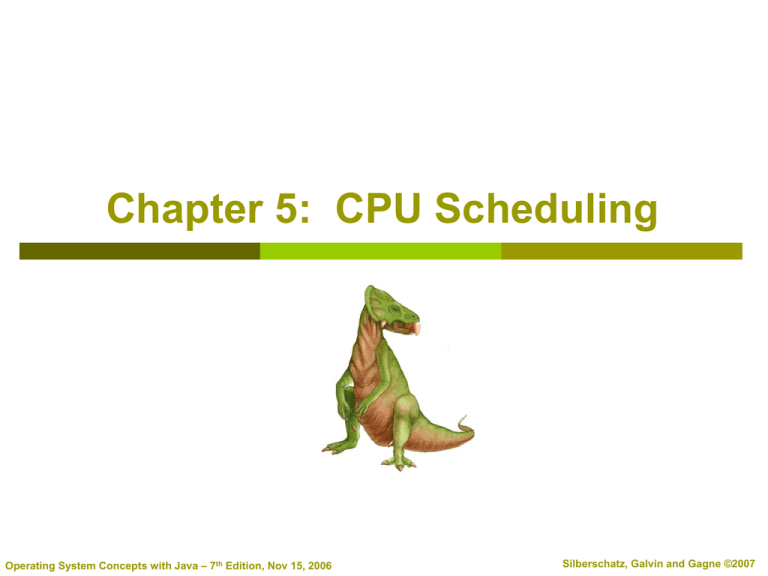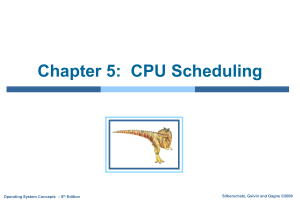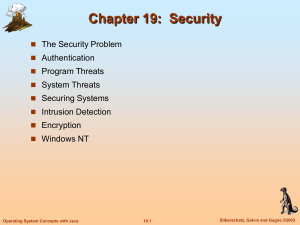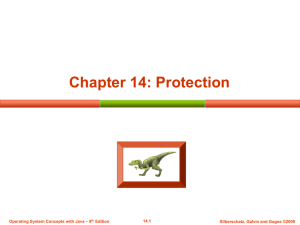
Chapter 5: CPU Scheduling
Operating System Concepts with Java – 7th Edition, Nov 15, 2006
Silberschatz, Galvin and Gagne ©2007
Chapter 5: CPU Scheduling
Basic Concepts
Scheduling Criteria
Scheduling Algorithms
Multiple-Processor Scheduling
Real-Time Scheduling
Thread Scheduling
Operating Systems Examples
Algorithm Evaluation
Operating System Concepts with Java – 7th Edition, Nov 15, 2006
5.2
Silberschatz, Galvin and Gagne ©2007
Basic Concepts
Maximum CPU utilization obtained with
multiprogramming
CPU–I/O Burst Cycle – Process execution
consists of a cycle of CPU execution and I/O
wait
CPU burst distribution
Operating System Concepts with Java – 7th Edition, Nov 15, 2006
5.3
Silberschatz, Galvin and Gagne ©2007
Alternating Sequence of CPU And I/O Bursts
Operating System Concepts with Java – 7th Edition, Nov 15, 2006
5.4
Silberschatz, Galvin and Gagne ©2007
Histogram of CPU-burst Times
Operating System Concepts with Java – 7th Edition, Nov 15, 2006
5.5
Silberschatz, Galvin and Gagne ©2007
CPU Scheduler
Selects from among the processes in memory that
are ready to execute, and allocates the CPU to one
of them
CPU scheduling decisions may take place when a
process:
1. Switches from running to waiting state
2. Switches from running to ready state
3. Switches from waiting to ready
4. Terminates
Scheduling under 1 and 4 is nonpreemptive
All other scheduling is preemptive
Operating System Concepts with Java – 7th Edition, Nov 15, 2006
5.6
Silberschatz, Galvin and Gagne ©2007
Dispatcher
Dispatcher module gives control of the CPU to the
process selected by the short-term scheduler; this
involves:
switching context
switching to user mode
jumping to the proper location in the user
program to restart that program
Dispatch latency – time it takes for the dispatcher
to stop one process and start another running
Operating System Concepts with Java – 7th Edition, Nov 15, 2006
5.7
Silberschatz, Galvin and Gagne ©2007
Scheduling Criteria
CPU utilization – keep the CPU as busy as possible
Throughput – # of processes that complete their execution
per time unit
Turnaround time – amount of time to execute a particular
process
Waiting time – amount of time a process has been waiting in
the ready queue
Response time – amount of time it takes from when a
request was submitted until the first response is produced,
not total output (for time-sharing environment)
E.g., when a Web page starts rendering (response time)
vs. when it finishes (turnaround time)
Fairness – does every job get a chance to run
Operating System Concepts with Java – 7th Edition, Nov 15, 2006
5.8
Silberschatz, Galvin and Gagne ©2007
Optimization Criteria
Max CPU utilization: percentage of time CPU is
not idle
Max throughput: processes completed over time
Min turnaround time: submission to completion
Min waiting time: time spent waiting in the queue
for service
Min response time: submission to beginning of
response
Operating System Concepts with Java – 7th Edition, Nov 15, 2006
5.9
Silberschatz, Galvin and Gagne ©2007
First-Come, First-Served (FCFS) Scheduling
Process
Burst Time
P1
24
P2
3
P3
3
Suppose that the processes arrive in the order: P1 , P2 , P3
The Gantt Chart for the schedule is:
P1
P2
0
24
P3
27
30
Waiting time for P1 = 0; P2 = 24; P3 = 27
Average waiting time: (0 + 24 + 27)/3 = 17
Operating System Concepts with Java – 7th Edition, Nov 15, 2006
5.10
Silberschatz, Galvin and Gagne ©2007
FCFS Scheduling (Cont.)
Suppose that the processes arrive in the order
P2 , P3 , P1
The Gantt chart for the schedule is:
P2
0
P3
3
P1
6
30
Waiting time for P1 = 6; P2 = 0; P3 = 3
Average waiting time: (6 + 0 + 3)/3 = 3
Much better than previous case
Convoy effect short process behind long process
Also called head of the line blocking
Operating System Concepts with Java – 7th Edition, Nov 15, 2006
5.11
Silberschatz, Galvin and Gagne ©2007
Shortest-Job-First (SJF) Scheduling
Associate with each process the length of its next CPU
burst. Use these lengths to schedule the process with the
shortest time
Two schemes:
nonpreemptive – once CPU given to the process it
cannot be preempted until process completes its CPU
burst
preemptive – if a new process arrives with CPU burst
length less than remaining time of current executing
process, preempt. This scheme is known as
Shortest-Remaining-Time-First (SRTF)
SJF is optimal – gives minimum average waiting time for a
given set of processes
Operating System Concepts with Java – 7th Edition, Nov 15, 2006
5.12
Silberschatz, Galvin and Gagne ©2007
Example of Non-Preemptive SJF
Process
Arrival Time
Burst Time
0.0
2.0
4.0
5.0
7
4
1
4
P1
P2
P3
P4
SJF (non-preemptive)
P1
0
3
P3
7
P2
8
P4
12
16
Average waiting time = (0 + 6 + 3 + 7)/4 = 4
Operating System Concepts with Java – 7th Edition, Nov 15, 2006
5.13
Silberschatz, Galvin and Gagne ©2007
Example of Preemptive SJF
Process
P1
P2
P3
P4
SJF (preemptive)
P1
0
P2
2
Arrival Time
0.0
2.0
4.0
5.0
P3
4
P2
5
Burst Time
7
4
1
4
P4
7
P1
11
16
Average waiting time = (9 + 1 + 0 +2)/4 = 3
Operating System Concepts with Java – 7th Edition, Nov 15, 2006
5.14
Silberschatz, Galvin and Gagne ©2007
Determining Length of Next CPU Burst
Can only estimate the length
Can be done by using the length of previous CPU
bursts, using exponential averaging
1. t n actual length of n th CPU burst
2. n 1 predicted value for the next CPU burst
3. , 0 1
4. Define :
n 1
t n 1 n .
Operating System Concepts with Java – 7th Edition, Nov 15, 2006
5.15
Silberschatz, Galvin and Gagne ©2007
Prediction of the Length of the Next CPU Burst
Operating System Concepts with Java – 7th Edition, Nov 15, 2006
5.16
Silberschatz, Galvin and Gagne ©2007
Examples of Exponential Averaging
=0
n+1 = n
Recent history does not count
=1
n+1 = tn
Only the actual last CPU burst counts
If we expand the formula, we get:
n+1 = tn+(1 - ) tn -1 + …
+(1 - )j tn -j + …
+(1 - )n +1 0
Since both and (1 - ) are less than or equal to 1, each
successive term has less weight than its predecessor
Operating System Concepts with Java – 7th Edition, Nov 15, 2006
5.17
Silberschatz, Galvin and Gagne ©2007
Priority Scheduling
A priority number (integer) is associated with each process
The CPU is allocated to the process with the highest
priority (smallest integer highest priority)
Preemptive
nonpreemptive
SJF is a priority scheduling where priority is the predicted
next CPU burst time
Problem Starvation – low priority processes may never
execute
Solution Aging – as time progresses increase the priority
of the process
Operating System Concepts with Java – 7th Edition, Nov 15, 2006
5.18
Silberschatz, Galvin and Gagne ©2007
Round Robin (RR)
Each process gets a small unit of CPU time (time
quantum), usually 10-100 milliseconds. After this time
has elapsed, the process is preempted and added to the
end of the ready queue.
If there are n processes in the ready queue and the time
quantum is q, then each process gets 1/n of the CPU time
in chunks of at most q time units at once. No process
waits more than (n-1)q time units.
Performance
q large FIFO
q small q must be large with respect to context
switch, otherwise overhead is too high
Operating System Concepts with Java – 7th Edition, Nov 15, 2006
5.19
Silberschatz, Galvin and Gagne ©2007
Example of RR with Time Quantum = 20
Process
P1
P2
P3
P4
The Gantt chart is:
P1
0
P2
20
37
P3
Burst Time
53
17
68
24
P4
57
P1
77
P3
97 117
P4
P1
P3
P3
121 134 154 162
Typically, higher average turnaround than SJF, but better
response
Operating System Concepts with Java – 7th Edition, Nov 15, 2006
5.20
Silberschatz, Galvin and Gagne ©2007
Time Quantum and Context Switch Time
Operating System Concepts with Java – 7th Edition, Nov 15, 2006
5.21
Silberschatz, Galvin and Gagne ©2007
Turnaround Time Varies With The Time Quantum
Operating System Concepts with Java – 7th Edition, Nov 15, 2006
5.22
Silberschatz, Galvin and Gagne ©2007
Multilevel Queue
Ready queue is partitioned into separate queues:
foreground (interactive)
background (batch)
Each queue has its own scheduling algorithm
foreground – RR
background – FCFS
Scheduling must be done between the queues
Fixed priority scheduling; (i.e., serve all from foreground
then from background). Possibility of starvation.
Time slice – each queue gets a certain amount of CPU
time which it can schedule amongst its processes; i.e.,
80% to foreground in RR
20% to background in FCFS
Operating System Concepts with Java – 7th Edition, Nov 15, 2006
5.23
Silberschatz, Galvin and Gagne ©2007
Multilevel Queue Scheduling
Operating System Concepts with Java – 7th Edition, Nov 15, 2006
5.24
Silberschatz, Galvin and Gagne ©2007
Multilevel Feedback Queue
A process can move between the various queues; aging
can be implemented this way
Multilevel-feedback-queue scheduler defined by the
following parameters:
number of queues
scheduling algorithms for each queue
method used to determine when to upgrade a process
method used to determine when to demote a process
method used to determine which queue a process will
enter when that process needs service
Operating System Concepts with Java – 7th Edition, Nov 15, 2006
5.25
Silberschatz, Galvin and Gagne ©2007
Example of Multilevel Feedback Queue
Three queues:
Q0 – RR with time quantum 8 milliseconds
Q1 – RR time quantum 16 milliseconds
Q2 – FCFS
Scheduling
A new job enters queue Q0 which is served FCFS. When
it gains CPU, job receives 8 milliseconds. If it does not
finish in 8 milliseconds, job is moved to queue Q1.
At Q1 job is again served FCFS and receives 16
additional milliseconds. If it still does not complete, it is
preempted and moved to queue Q2.
Operating System Concepts with Java – 7th Edition, Nov 15, 2006
5.26
Silberschatz, Galvin and Gagne ©2007
Multilevel Feedback Queues
Operating System Concepts with Java – 7th Edition, Nov 15, 2006
5.27
Silberschatz, Galvin and Gagne ©2007
Multiple-Processor Scheduling
CPU scheduling more complex when multiple
CPUs are available
Homogeneous processors within a
multiprocessor
Load balancing – keep workload evenly
distributed
Processor affinity – benefits of past history in a
processor
Why run a process on the same processor?
Asymmetric multiprocessing – only one
processor accesses the system data structures,
alleviating the need for data sharing
Operating System Concepts with Java – 7th Edition, Nov 15, 2006
5.28
Silberschatz, Galvin and Gagne ©2007
Real-Time Scheduling
Real-time processes have timing constraints
Expressed as deadlines or rate requirements
Hard real-time systems – required to complete a critical
task within a guaranteed amount of time
Soft real-time computing – requires that critical processes
receive priority over less fortunate ones
Common RT scheduling policies:
Rate monotonic
Just one scalar priority related to the periodicity of
the job
Priority = 1/rate
Static
Earliest deadline first (EDF)
Dynamic but more complex
Priority = deadline
Both require admission control to provide guarantees
Operating System Concepts with Java – 7th Edition, Nov 15, 2006
5.29
Silberschatz, Galvin and Gagne ©2007
Thread Scheduling
Local Scheduling – How the threads library
decides which thread to put onto an available
LWP
Global Scheduling – How the kernel decides
which kernel thread to run next
Operating System Concepts with Java – 7th Edition, Nov 15, 2006
5.30
Silberschatz, Galvin and Gagne ©2007
Linux Scheduling
Two algorithms: time-sharing and real-time
Time-sharing
Prioritized credit-based – process with most credits is
scheduled next
Credit subtracted when timer interrupt occurs
When credit = 0, another process chosen
When all processes have credit = 0, recrediting occurs
Based on factors including priority and history
Real-time
Soft real-time
Posix.1b compliant – two classes
FCFS and RR
Highest priority process always runs first
Operating System Concepts with Java – 7th Edition, Nov 15, 2006
5.31
Silberschatz, Galvin and Gagne ©2007
The Relationship Between Priorities and Time-slice length
Operating System Concepts with Java – 7th Edition, Nov 15, 2006
5.32
Silberschatz, Galvin and Gagne ©2007
List of Tasks Indexed According to Priorities
Operating System Concepts with Java – 7th Edition, Nov 15, 2006
5.33
Silberschatz, Galvin and Gagne ©2007
Policy versus Mechanism
Separate what is done vs. how it is done
Put some basic mechanism (or mechanisms) in the
kernel
Permit user processes to set parameters that control
scheduling
Simple example: nice command
Operating System Concepts with Java – 7th Edition, Nov 15, 2006
5.34
Silberschatz, Galvin and Gagne ©2007
Algorithm Evaluation
First: What criteria are you optimizing for?
CPU utilization, throughput, response time, etc.
Deterministic modeling – Gantt charts
takes a particular workload
Evaluate performance of each algorithm for that
workload
Queuing models
Analytic approach using math, distributions, algorithms,
assumptions
Simulation
Distribution-driven or trace-based
Implementation
Expensive
Also dependent on workload
Operating System Concepts with Java – 7th Edition, Nov 15, 2006
5.35
Silberschatz, Galvin and Gagne ©2007
Algorithm Evaluation
Evaluation of CPU schedulers by simulation
Operating System Concepts with Java – 7th Edition, Nov 15, 2006
5.36
Silberschatz, Galvin and Gagne ©2007
Algorithm Evaluation
Operating System Concepts with Java – 7th Edition, Nov 15, 2006
5.37
Silberschatz, Galvin and Gagne ©2007
The Importance of Workloads
What kind of workload?
Networking: Web pages, VoIP calls, P2P, IM, Email…
Database: Transactions, decision support systems
CPU: scientific, financial, software development
Obtaining workloads
Privacy, legality, competitive advantages, etc.
How representative are workloads?
University vs. Corporation vs. Government vs. Home user
US vs. Asia vs. Europe
Variation in the workload
Time-of-day effects
Size of jobs can span multiple orders of magnitude
Operating System Concepts with Java – 7th Edition, Nov 15, 2006
5.38
Silberschatz, Galvin and Gagne ©2007
End of Chapter 5
Operating System Concepts with Java – 7th Edition, Nov 15, 2006
Silberschatz, Galvin and Gagne ©2007
Scheduling – Process Behavior
Bursts of CPU usage alternate with periods of waiting for
I/O. (a) A CPU-bound process. (b) An I/O-bound
process.
Example from Tanenbaum, Modern Operating Systems 3 e, (c) 2008 Prentice-Hall, Inc. All rights reserved. 0-13-6006639
Operating System Concepts with Java – 7th Edition, Nov 15, 2006
5.40
Silberschatz, Galvin and Gagne ©2007
Categories of Scheduling Algorithms
1.
2.
3.
Batch
Interactive
Real time
Example from Tanenbaum, Modern Operating Systems 3 e, (c) 2008 Prentice-Hall, Inc. All rights reserved. 0-13-6006639
Operating System Concepts with Java – 7th Edition, Nov 15, 2006
5.41
Silberschatz, Galvin and Gagne ©2007
Scheduling Algorithm Goals
Scheduling algorithm goals under different circumstances.
Example from Tanenbaum, Modern Operating Systems 3 e, (c) 2008 Prentice-Hall, Inc. All rights reserved. 0-13-6006639
Operating System Concepts with Java – 7th Edition, Nov 15, 2006
5.42
Silberschatz, Galvin and Gagne ©2007
Scheduling in Batch Systems
First-come first-served
Shortest job first
Shortest remaining Time next
Example from Tanenbaum, Modern Operating Systems 3 e, (c) 2008 Prentice-Hall, Inc. All rights reserved. 0-13-6006639
Operating System Concepts with Java – 7th Edition, Nov 15, 2006
5.43
Silberschatz, Galvin and Gagne ©2007
Shortest Job First
An example of shortest job first scheduling.
(a) Running four jobs in the original order. (b) Running them
in shortest job first order.
Example from Tanenbaum, Modern Operating Systems 3 e, (c) 2008 Prentice-Hall, Inc. All rights reserved. 0-13-6006639
Operating System Concepts with Java – 7th Edition, Nov 15, 2006
5.44
Silberschatz, Galvin and Gagne ©2007
Scheduling in Interactive Systems
Round-robin scheduling
Priority scheduling
Multiple queues
Shortest process next
Guaranteed scheduling
Lottery scheduling
Fair-share scheduling
Example from Tanenbaum, Modern Operating Systems 3 e, (c) 2008 Prentice-Hall, Inc. All rights reserved. 0-13-6006639
Operating System Concepts with Java – 7th Edition, Nov 15, 2006
5.45
Silberschatz, Galvin and Gagne ©2007
Round-Robin Scheduling
Round-robin scheduling.
(a) The list of runnable processes. (b) The list of runnable
processes after B uses up its quantum.
Example from Tanenbaum, Modern Operating Systems 3 e, (c) 2008 Prentice-Hall, Inc. All rights reserved. 0-13-6006639
Operating System Concepts with Java – 7th Edition, Nov 15, 2006
5.46
Silberschatz, Galvin and Gagne ©2007
Priority Scheduling
A scheduling algorithm with four priority classes.
Example from Tanenbaum, Modern Operating Systems 3 e, (c) 2008 Prentice-Hall, Inc. All rights reserved. 0-13-6006639
Operating System Concepts with Java – 7th Edition, Nov 15, 2006
5.47
Silberschatz, Galvin and Gagne ©2007
Thread Scheduling (1)
(a) Possible scheduling of user-level threads with a 50-msec
process quantum and threads that run 5 msec per CPU burst.
Example from Tanenbaum, Modern Operating Systems 3 e, (c) 2008 Prentice-Hall, Inc. All rights reserved. 0-13-6006639
Operating System Concepts with Java – 7th Edition, Nov 15, 2006
5.48
Silberschatz, Galvin and Gagne ©2007
Thread Scheduling (2)
(b) Possible scheduling of kernel-level threads with the
same characteristics as (a).
Example from Tanenbaum, Modern Operating Systems 3 e, (c) 2008 Prentice-Hall, Inc. All rights reserved. 0-13-6006639
Operating System Concepts with Java – 7th Edition, Nov 15, 2006
5.49
Silberschatz, Galvin and Gagne ©2007
Java Scheduling
Loosely-defined scheduling policy. A thread
runs until:
1. It’s time quantum expires
2. It blocks for I/O
3. It exits its run() method
Some systems may support preemption
Operating System Concepts with Java – 7th Edition, Nov 15, 2006
5.50
Silberschatz, Galvin and Gagne ©2007
Java Scheduling
Priorities - values range from 1-10
MIN_PRIORITY is 1
NORM_PRIORITY is 5
MAX_PRIORITY is 10
Operating System Concepts with Java – 7th Edition, Nov 15, 2006
5.51
Silberschatz, Galvin and Gagne ©2007
Java Scheduling
Changing priority using setPriority()
Operating System Concepts with Java – 7th Edition, Nov 15, 2006
5.52
Silberschatz, Galvin and Gagne ©2007
Java Scheduling
Relationship between Java and Win32 Priorities
Operating System Concepts with Java – 7th Edition, Nov 15, 2006
5.53
Silberschatz, Galvin and Gagne ©2007
Java Scheduling
Java thread scheduling on Solaris
Operating System Concepts with Java – 7th Edition, Nov 15, 2006
5.54
Silberschatz, Galvin and Gagne ©2007
Pthread Scheduling API
Operating System Concepts with Java – 7th Edition, Nov 15, 2006
5.55
Silberschatz, Galvin and Gagne ©2007
Solaris Scheduling
Operating System Concepts with Java – 7th Edition, Nov 15, 2006
5.56
Silberschatz, Galvin and Gagne ©2007
Solaris Dispatch Table
Operating System Concepts with Java – 7th Edition, Nov 15, 2006
5.57
Silberschatz, Galvin and Gagne ©2007
Windows XP Priorities
Operating System Concepts with Java – 7th Edition, Nov 15, 2006
5.58
Silberschatz, Galvin and Gagne ©2007






